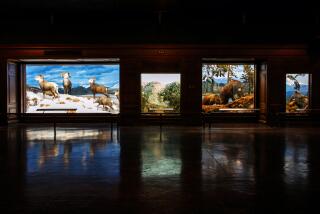ART REVIEW : Fertile Collection of the Changing Landscape
- Share via
We in the 20th Century are comfortable with the idea that what’s depicted in a painting isn’t necessarily the subject of the painting. That’s old hat to us, but as can be seen in an exhibition of landscape drawings and prints on view at UCLA’s Frederick S. Wight Gallery through Dec. 17, it’s a relatively new idea.
For several centuries prior to the invention of the camera, it was a central concern for artists that they function as accurate recording devices. While the values and ideas of artists and their day invariably crept into art in subtle ways, most pictorial art strove to offer an objective depiction of the physical world.
Consequently, it requires a well-trained eye indeed to detect the flourishes of subjective interpretation in the 154 images included in “The Rudolf L. Baumfeld Collection of Landscape Drawings and Prints.” Drawn from Baumfeld’s 857-piece collection of Western landscape art (which he donated to UCLA on his death last year), these small, self-effacing images refrain from trumpeting the fact that they chronicle a history of civilization (as well as the story of specific individuals), and you have to look closely to get the picture.
Pure landscape first appeared as a primary subject in art in 16th-Century Germany. As man began to expand on the functions of art--which previously had operated almost exclusively as a mediator between man and God--artists now began to reflect objectively on the physical world. The genre didn’t hit its stride, however, until the 17th Century in the Netherlands (which introduced realistic scenes of villages as legitimate subject matter), then went on to experience highly fertile periods in 19th-Century France, and from the 18th to the early 20th centuries in England.
Representing every Western tradition in landscape art, the exhibition (curated by Cynthia Burlingham) is divided by country into seven sections that share certain common attitudes. Most of the work favors renaissance perspective, the balanced approach to composition associated with classical art, and a cool, studied neutrality toward subject matter. There’s virtually none of the bombastic splendor of landscape artists of the Frederick Church ilk, who interpreted the majesty of nature as proof of the existence of God. Drawn instead to a rational and harmonious view of nature, these artists valued geologic exactitude and precision of rendering, and their work is almost entirely free of extravagant gesture.
Pastoral scenes and urban views abound here, and there’s lots of fairy-tale scenery too--crumbling castles, quaint cottages with thatched roofs, verdant village greens. Another theme that turns up repeatedly is the exotic foreign locale. Dutch artists were particularly fascinated by the ruins and terrain of Italy, and Italianate prints were popular in the Netherlands. Ruins were a hot ticket in nearly every country represented in fact, and artists always imbued them with great nobility. Apparently, the impulse to idealize the past--something very much with us today--has long been a part of human nature.
Most of these images convey the impression of topographical accuracy but, contrary to appearance, artists didn’t feel bound by reality. Rembrandt introduced the innovation of integrating natural phenomena with idealized landscape motifs, while similarly, Italian artist Canaletto combined straightforward views with fantasy architecture. (Italian landscape art didn’t hit its stride until the 18th Century, when the flourishing tourist trade in Venice and Rome led to an increased demand for prints of local scenery. So, don’t feel like a Philistine if these images remind you of picture post cards).
The 19th Century ushered in a new emphasis on the artist’s personal experience of nature, which was reflected in an increased concern with atmosphere and the direct application of color. Impressionism dominates the French section of the show, and in these images light takes precedence over the terrain depicted as the central subject. Here we find the glimmerings of modernism, as nature is reduced to abstracted patterns of light and dark.
It’s hard to say how images of nature affect our experience of the real thing. However, it can be said that these modest mementos of scenes glimpsed and remembered don’t encroach on the grandeur of the physical world in quite the same way a massive movie screen does. Hushed and respectful, they’re more like prayers than pictures.
More to Read
The biggest entertainment stories
Get our big stories about Hollywood, film, television, music, arts, culture and more right in your inbox as soon as they publish.
You may occasionally receive promotional content from the Los Angeles Times.










